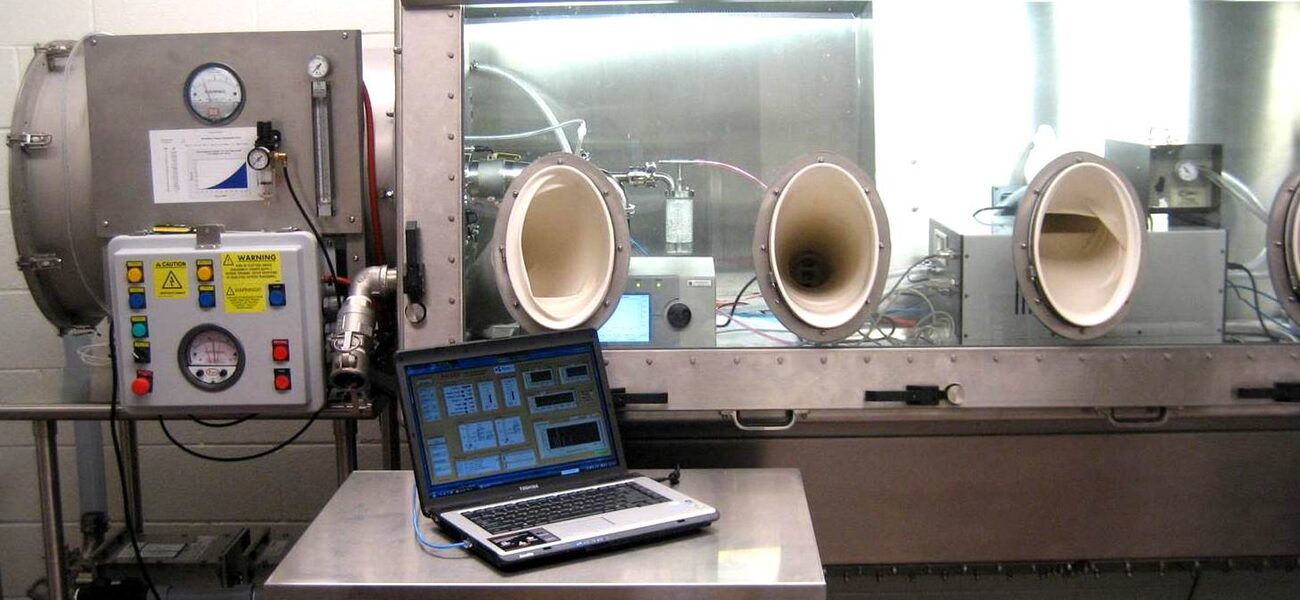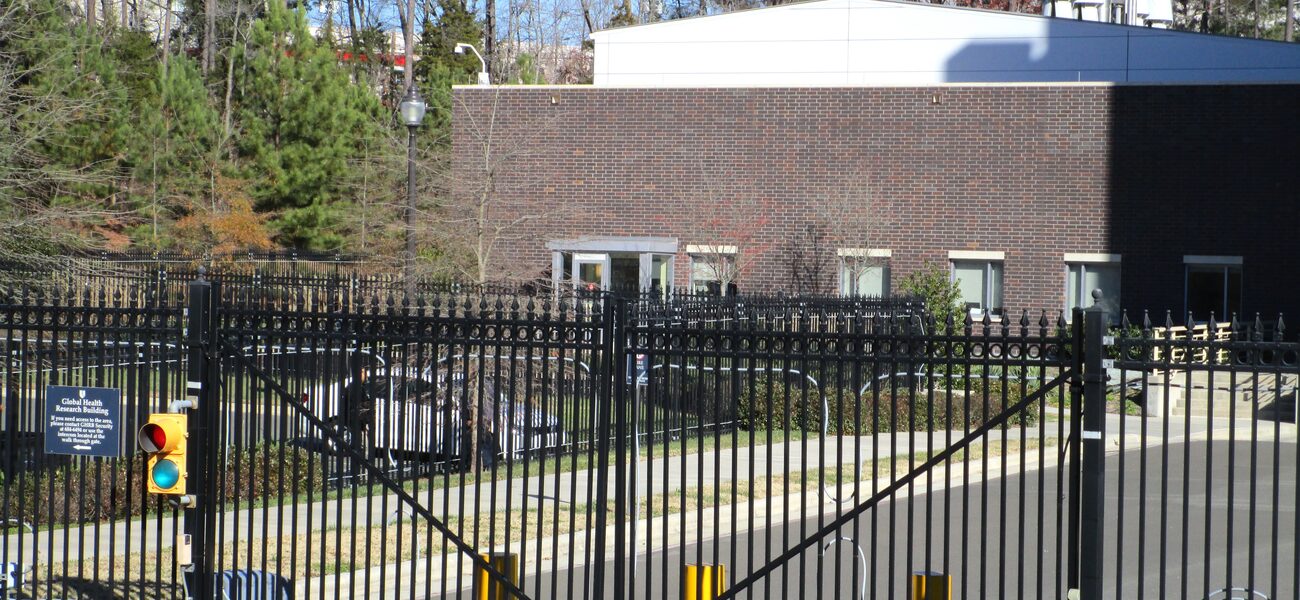Researchers at Duke University Medical Center’s Regional Biocontainment Lab (RBL) recently organized and launched a select-agent-based study in just 30 days from inception to conclusion, thanks to the organization’s highly efficient operational framework. Fast tracking of the study—which involved aerosol exposure of 38 immunized mice to Francisella tularensis, the causative agent of tularemia—was made possible through the facility’s strategic management and cross-trained staffing model.
“It’s really the outstanding personnel on our RBL team that made this possible,” says Scott Alderman, director of safety and RBL operations at Duke University Medical Center. [See sidebar on personnel.] “We also have a strong commitment from our institutional leadership to operate this facility in an efficient, compliant, and safe manner on a daily basis.”
Duke University’s RBL contains approximately 4,000 sf of high-containment BSL-3 and ABSL-3 space, including eight labs and two animal suites. In the case study, a principal investigator (PI) asked whether it was feasible to conduct a tularemia vaccine study, to be completed in 30 days, involving full-body aerosol exposure of immunized mice with necropsies occurring seven days after exposure.
“The answer to that researcher’s request was ‘yes,’” says Alderman. “But only because we have the right operational framework already in place to respond efficiently.”
Days 1 to 14
How does Duke’s RBL safely launch a select agent study in such a short period?
It starts with the director of safety and operations meeting with the scientists and lab staff to gain a solid understanding of what needs to be performed. This allows him to develop an experimental plan and assign the necessary lab space.
The research staff then populates a form with basic information about the experiment and submits it to the animal models manager for review before passing it to the safety director. The animal models manager reviews the required animal model and orders the mice, which are delivered in about 10 days.
A building lab assistant prepares the designated lab with common supplies, and researchers set the lab up with specialized equipment. Per standard operating procedure (SOP), the lab assistant also performs a hydrogen peroxide decontamination of the space, if it was previously used for a different agent. This greatly minimizes the risk of cross contamination from one experiment to the next.
The director of safety and operations then works closely with the security team to limit lab access only to individuals approved to handle select agents, in compliance with select agent rules.
“At that point, we verify that appropriate SOPs are in place, confirm that site-specific training for all relevant staff is documented, ensure compliance with occupational health requirements, and make sure proper biohazard signage is in place,” says Alderman. “Once the final authorization is granted, we are ready to go with the experiment.”
Days 15 to 17
In week three, the safety director removes the F. tularensis sample from the long-term storage freezer and delivers it to the assigned lab and the select-agent-approved individual who requested it.
“Once the researcher takes ownership of the sample, a culture of the bacterium is started, the propagation of the material ultimately used to create an inoculum for infecting animals,” says Alderman. “At the same time, the research team is preparing the animals for the study. This includes ear-tagging them for proper tracking, collecting weight measurements, and ensuring compliance with all husbandry requirements.”
When the team is ready to deliver the select agent via aerosol, the inoculum is given to the aerobiology manager, who prepares the nebulizer and the Madison aerosol chamber—a containment system specially designed for high-containment labs that allows for total body exposure of small animals.
After mice are exposed and moved out of the chamber and back into their cages, the chamber and containment area are decontaminated with hydrogen peroxide vapor. Biohazard signage is then added to the cages to ensure proper communication with staff responsible for animal care.
Days 18 to 30
Mice are monitored for the next seven days. Researchers weigh them daily, because weight is a significant indicator of the animal’s wellbeing. Blood samples are collected on certain dates for analysis of each animal’s immune response.
Additionally, the safety officer comes in at least once during this stage to perform a select agent compliance audit.
“The animals are euthanized when they show signs of sickness or at the end of that seven-day period,” says Alderman. “And then the researchers perform necropsies, do titers on certain organs, get the final bacterial counts, and send the collected data out of the lab electronically. Since we have computers in each of our labs, researchers don’t have to worry about bringing out paperwork, which further streamlines the efficiency of operation.”
Autoclave Save
One of the biggest success stories of the case study was the rapid repair of a primary autoclave serving the animal suite where the research was being conducted.
When the autoclave went out of service on day 20 of the experiment, the RBL team was able to get it back online quickly because it is not reliant on an outside contractor for autoclave failures.
“We prefer not to bring waste out of the animal suite without autoclaving it,” says Alderman. “Since our senior maintenance mechanic is certified to service our autoclave units, he was able to fix the problem promptly.”
“During the initial few months of operation for the RBL, autoclave failures were commonplace. At the time, we relied on an out-of-town service contractor to repair our units,” he says. “It typically took three to four days to get an autoclave back up and running, and that was just not acceptable. So we sent two of our mechanics to be trained as certified technicians by the manufacturer. Now they can diagnose and correct the majority of failures that occur with our autoclaves, and we’ve seen downtimes drop from three to four days down to a few hours.”
CDC Inspection
Each registered select agent facility is subject to an unannounced federal inspection, and CDC inspections are required by law to occur at least every three years. According to Alderman, being ready for this type of surprise inspection requires constant communication between the responsible official, the select agent principal investigator, and the director of safety and operations.
“You are required to have an updated biosafety, security, and incident-response plan on file,” says Alderman. “A drill of each plan must be documented on a routine basis. In addition, it is important to organize all training and compliance logs in a manner that is easily retrieved and presentable.”
Other critical audit elements include having properly trained workers in all relevant disciplines, having proper security features, and keeping organized records of annual facility verification data.
At the RBL, the director of safety conducts routine audits of lab activities, some of which are performed remotely using CCTV footage instead of disrupting operations by physical presence in the space.
Maximizing BSL Efficiency
The Duke case study reveals some of the most important aspects of maintaining an efficiently operating biocontainment lab that can rapidly execute new select agent experiments and always be prepared for surprise inspections: a strong institutional commitment to excellence, a customized database for scheduling and tracking of lab space and equipment, extensive cross-training of staff, and a trained maintenance person on site with appropriate spare parts available for immediate use.
“It’s very helpful that we’ve taken the time to cross-train a number of our personnel, so that if someone calls in sick or takes vacation, normal operation continues. Another key is constant communication across the multiple disciplines that make up our facility staff. That’s a big part of our success. The efficiency with which our facility operates is really due to the fact that we have a terrific team.”
By Johnathon Allen
This report is based on a presentation by Scott Alderman at Tradeline’s International Biocontainment Facilities 2014 conference.


